The Vanishing
In the stunning and remote wilderness along northern British Columbia’s Highway 16, at least 18 women—by some estimates, many more—have gone missing over the past four decades. After years of investigation, authorities still don’t know if it’s the work of a serial killer or multiple offenders. Bob Friel drives into the darkness for answers.
Heading out the door? Read this article on the Outside app available now on iOS devices for members! Download the app.
For generations, the young people of Vanderhoof, British Columbia, have raced through the night down Blackwater Road, their four-wheel drives kicking up gravel as they spin onto a rutted track scraped through the evergreen woods surrounding Hogsback Lake. By day, this small park is a peaceful spot for a picnic, a paddle, or setting off to hike a stretch of nearby Telegraph Trail. After dark, Hogsback’s shoreline offers a great place to throw a party.
On Friday, May 27, 2011, Madison Scott, 20, threaded her hand-me-down 1991 F150 between fir trees and parked in a grassy clearing at the edge of the lake. With long ginger hair, green eyes, a big smile, and a spray of freckles across her pierced nose, Maddy radiated life. A 2009 graduate of Vanderhoof’s Nechako Valley Secondary School, she stood a sturdy five foot four and 170 pounds, and had played ice hockey and rugby.
Growing up in Vanderhoof, a small (pop. 4,800) mill town punched square on the sawdust belt of this rugged Canadian province, Maddy was a real northern B.C. girl. She’d dress up for a dance but was also comfortable atop a horse, dirt bike, or snowmobile. She could handle a socket wrench and had recently begun an apprenticeship as a mechanic in her father’s shop.
Maddy’s softer side showed a passion for photography. She focused her camera on birds, flowers, friends, and especially her younger sister. During one long exposure, an uncharacteristically serious-faced Maddy posed on a bleak snow-covered field. She set off the flash, then walked out of the frame, leaving a haunting image of her body dissolving into the night. In the winter of 2010, one of her cousins commented on the photo on Facebook, saying, “I don’t like ghost stuff.” Maddy responded, “Haha, you’re a baby!!”
The day Maddy drove to Hogsback Lake, a windy front had blown itself out by early morning, but it remained unseasonably cool and overcast, never breaking 50 degrees. The forecast called for it to drop into the low forties that night. Still, Maddy planned on camping at the lake with one of her girlfriends after the party. She climbed down from her truck and staked out her two-tone blue nylon tent. Then, dressed in a black T-shirt and capri jeans, she joined the fun.

The clearing filled with about 50 people, all from the Vanderhoof area, a mix of 18-to-25-year-olds with a few oldsters mingled in. No one who attended wants to publicly say what went on, partywise. In general, folks say it was what happens whenever young people gather in the woods at night—the same thing their parents had done when they, too, hung out at Hogsback Lake decades before.
The party rolled deep into the morning. Maddy’s girlfriend reportedly went home early after hurting her knee, but Maddy decided to stay and camp alone. The latest anyone admits to seeing her was around 3 a.m.
All the next day, Saturday, Maddy’s truck and tent sat in the middle of the park’s most trampled spot. On Saturday night, there was an even bigger gathering at the same clearing, with as many as 150 people partying all around Maddy’s campsite. No one, though, says they saw her.
Well-known in the small town, Maddy had dozens of friends and a large extended family that owned part of a local lumber mill and Vanderhoof’s grocery store, Scott Foods. She was also an experienced camper who’d been to Hogsback many times. Still, by Sunday morning, when not one of her friends or family had heard from her since the party, Maddy’s parents, Eldon and Dawn Scott, drove out to the lake. They found her truck, tent, and purse intact but no Maddy. They immediately called the Vanderhoof detachment of the Royal Canadian Mounted Police (RCMP).
When the Mounties arrived, they didn’t see any sign of a struggle, a flat tire or any other reason Maddy would have ditched her truck, or any bear or cougar tracks. Maddy’s keys and iPhone were gone. It looked as if she’d simply walked off or gotten into another vehicle. However, with the Scotts prominent in the community, and Maddy known as a responsible, hardworking kid, there was no hemming and hawing about whether this was a legitimate missing-person case.
“Something was obviously amiss,” says RCMP sergeant Rob Vermeulen. The local police called in search-and-rescue teams from Vanderhoof, the small neighboring communities of Fort St. James and Burns Lake, and northern B.C.’s largest city, Prince George (pop. 80,000), an hour east on Highway 16. They also quickly looped in B.C.’s North District Major Crime Unit.
But Madison Scott had disappeared into the night.
One young woman from a close community gone missing is heartbreaking enough. Go a little wider on the map, though, and Vanderhoof becomes just another of a series of tragic waypoints along a slice of northern B.C. where there are dozens of unsolved cases of women and girls who’ve vanished or been murdered going back four decades. The only link between many of the cases remains proximity to Highway 16, a road now infamously known as the Highway of Tears.
Sixteen’s less ominous alias is the Yellowhead Highway, a 1,700-mile road from Winnipeg to Prince Rupert named in honor of Pierre Bostonais, a blond Métis mountain man who blazed the route west across the Rockies in the early 19th century. B.C.’s strand of the Yellowhead is a ruggedly beautiful run from the Alberta provincial line to the Pacific coast. The lonely 450-mile stretch from Prince George to the port of Prince Rupert is the portion that has earned the Tears epithet.
The road has barely left Prince George—ranked Canada’s most dangerous city two years running for its epidemic of drug and gang violence—when the first MOOSE CROSSING sign appears. It’s a fitting symbol of the duality of this part of B.C., where a fragment of urban affliction butts up against spectacular scenery, where clear-cuts mark the edges of some of North America’s last wild places, where Alaska-bound $500,000 motor homes stream past struggling First Nations villages and small mill towns.

Put the murders and the missing out of mind and Highway 16 serves as a mainline adventure artery connecting jumping-off points for exploring the B.C. wilderness. A stuffed grizzly waves a glass-eyed welcome from the chamber of commerce in the small town of Houston, while a salmon statue marks excellent steelhead country—the highway rarely wanders far from good casting its entire length. Smithereens, the 5,400 residents of alpine-themed Smithers, live beside—and bike, ski, and climb—the startling bulk of 7,648-foot Hudson Bay Mountain, which towers above the highway. After breaching the Coast Mountains, the road stops at Prince Rupert, where boats carry fishermen to halibut and salmon grounds, whale watchers to humpbacks, and bear lovers to the Khutzeymateen Grizzly Sanctuary.
Drive Highway 16 long enough and you’ll feel its fickle personality. The two-lane gray-top demands your attention. Past the town of Terrace, it begins to wrap around the mountains, and you learn to hug the edges of sharp, often rain-slicked turns where top-heavy lumber trucks threaten to spill into your lane.
Towns like Vanderhoof are relatively upscale bumps along the highway, though it, too, has been dragged up and down northern B.C.’s boom-and-bust cycles. The settlements are strung far apart, and the road slows as it passes through each one. Some of the isolated First Nations villages are little more than smatterings of mobile homes, handmade log cabins, and cinder-block motels. The farther west you drive, the tougher things look.
“We’re in the 75 to 85 percent range of unemployment in these villages,” says Mark Starlund, chief counsel of the Gitanyow, a First Nations band long known for their skill at carving cedar totems. “There are a lot of unemployed and underemployed. A family might live on $1,000 a month in social assistance. That’s brutal, Third World poverty.”
A few minutes from any of the towns or settlements and you’re in vast forest. Convenient for anyone trying to dump a body, skid roads slash through every sizable patch of trees near the highway, especially east of the mountains. It’s often left to hikers or hunters to stumble upon a victim’s remains.
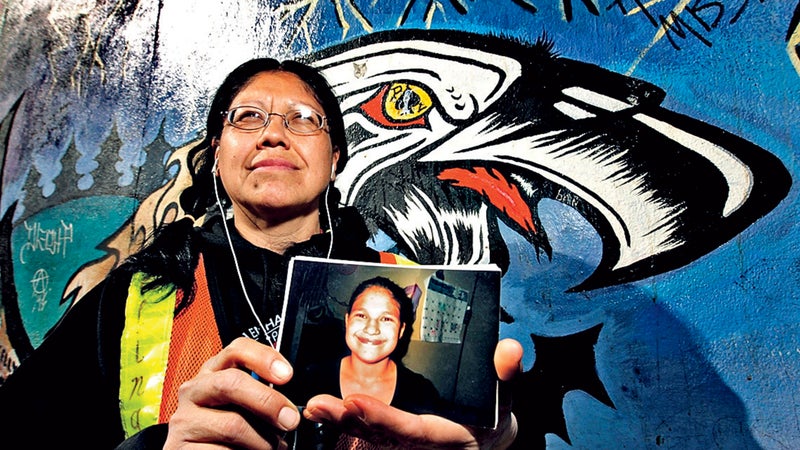
Billboards on 16 warning KILLER ON THE LOOSE! are constant reminders of the missing. The disappearances along the highway and two of its desolate tributaries, Highways 97 and 5, date back to 1969, when 26-year-old Gloria Moody was found murdered near Williams Lake. There have been clusters of disappearances each decade since, but it’s difficult to get a handle on the actual number of victims.
In testimony to B.C.’s Missing Women Commission of Inquiry—formed in 2010, mainly to investigate why it took law enforcement so long to catch Willie “the Pig Farmer” Pickton, a serial killer who preyed on Vancouver women from 1995 through 2001—First Nations bands and local community groups claimed that as many as 43 women have been killed or gone missing along Highway 16. In 2005, the RCMP created a special unit called E-Pana (E is the RCMP designation for all things British Columbian, and Pana is an Inuit god who caretakes souls in a frozen underworld before reincarnation) to examine some of the disappearances and to determine whether another serial killer was at work. Its investigators eventually sorted through hundreds of unsolved murders, missing women, and sexual assaults in B.C. over the past four decades and found that 18 cases shared enough similarities to be possibly linked.
The number of cases E-Pana took on was limited by certain criteria. Investigators considered adding a case only if the victim was female, had been involved in a high-risk activity, such as hitchhiking or the sex trade, and had disappeared or been found murdered within a mile of Highway 16, 97, or 5. Nine of E-Pana’s victims are aboriginal, and nine are Caucasian. They range in age from 12 to 33; 12 of them are under the age of 20.
Then, in 2009, The Vancouver Sun used similar criteria but widened the search beyond a one-mile limit to come up with 31 cases of missing women in the general area, all of them similar enough to be potentially linked.
Thumbing a ride is one of the major risk factors for women who end up on the Highway 16 lists. Caution-yellow billboards insist GIRLS DON'T HITCHHIKE ON THE HIGHWAY OF TEARS. But they do. “What scares me,” says Starlund, “is that you can drive this highway today and still see young girls hitchhiking even when they know what’s going on. But it’s not like they can ask, ‘Mom, can I borrow your car?’ because Mom’s so poor she doesn’t have a car.” Two women from Mark Starlund’s Gitanyow band are on E-Pana’s list of 18.
The idea of getting regular public transportation running between the communities comes up every time there’s a study group or public meeting. “We started the Kitwancool bus on welfare day so people can get to Terrace to cash their checks,” says Starlund. “Some other villages do that same kind of thing, but that’s just a couple of times a month.” The rest of the time, there might be no other option than hitching if these girls want to get someplace.
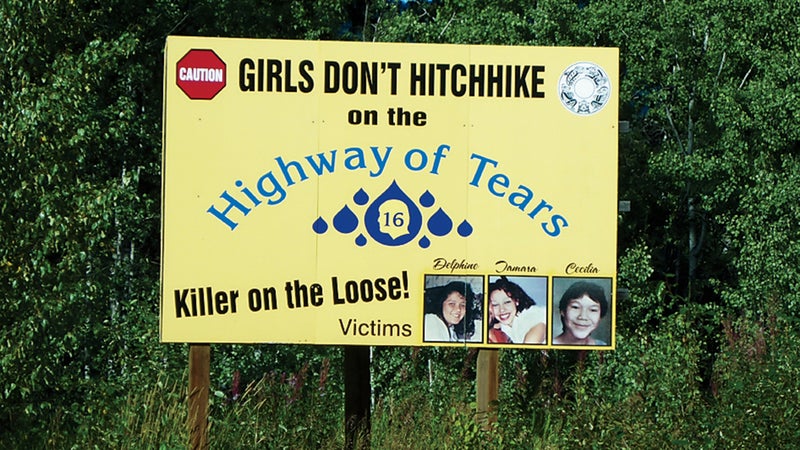
There are other Tears cases where the girls were doing nothing riskier than riding their bikes, walking, or hanging out with friends near the highway that runs through their small town—like 12-year-old Monica Jack, who was plucked off her bike near Nicola Lake in 1978. Her remains were discovered 17 years later on a logging road.
No new cases have been added to E-Pana’s list since 2006, but that doesn’t mean that the region’s murders and disappearances have ended. Between October 2009 and September 2010, three Prince George women went missing. Two were found murdered. One has yet to be recovered, though RCMP officials—who created another special unit, called E-Prelude, to investigate these cases—say they have evidence that she was killed.
And then, most recently, there’s Maddy Scott, who was at a party with friends. Because she disappeared some 10 miles from the highway and wasn’t involved in anything considered high-risk, Maddy isn’t on E-Pana’s Highway of Tears list. “There is nothing to indicate at this time that Maddy’s disappearance is connected to the ongoing E-Pana investigations,” says RCMP constable Lesley Smith, the spokeswoman for North District Major Crime.
But for the people living in the small communities along 16, all the chilling tales start to run together.
When North District Major Crime, the RCMP unit that handles the most serious cases in that part of the province, took charge of Maddy Scott’s file, a dozen investigators poured into Vanderhoof and began working the case from a crime angle—doing forensics and interviewing potential witnesses—at the same time the search was still ramping up.
Bloodhounds strained to latch onto Maddy’s scent. Aircraft mounted with infrared cameras probed the bush. Boats towed underwater cameras and side-scan sonar arrays through Hogsback Lake; divers searched its silty bottom. Even the Canadian Rangers—local detachments of the Army—joined in the effort. Within a day, 150 volunteers had shown up to help.
On May 31, 2011, four days after Maddy’s disappearance, the RCMP suspended the search. The volunteers, however, kept looking. On June 21, Maddy’s parents offered a $15,000 reward, which they eventually raised to $25,000. (It has since been raised again, to $50,000.) In a September 1 statement, the Scotts asked those with any information to come forward and thanked the tight-knit community. “We have always loved living here,” they said, “and it is often in a time of crisis that you truly see the network of support that exists in an area that we are proud to call home.” But the days and weeks dragged on, with no results. At press time, 11 months after she went missing, there was still no sign of Maddy.
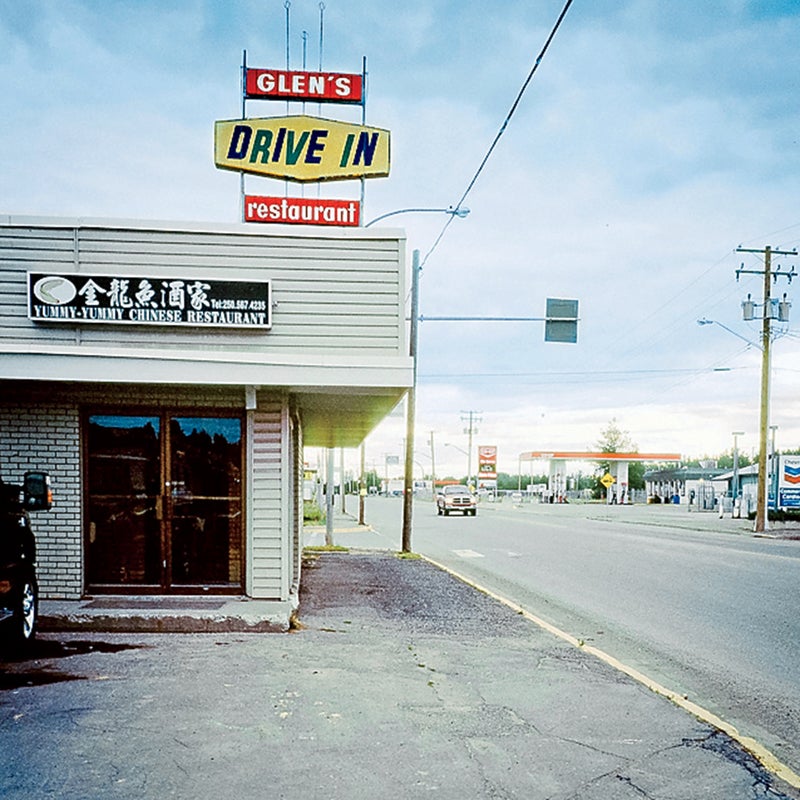
The RCMP’s E-Pana hasn’t made much progress on its cases, either. The special unit has grown to a team of 50 people with an annual budget of $6 million, and investigators have come up with thousands of persons of interest. E-Pana began doing background checks and profiles on more than 2,000 possible suspects. Then it cast an even wider net, over an additional 5,000 persons of interest. The project received 1,006 tips in 2010 alone and has made 16,000-plus inquiries since its creation in 2005.
Though the unit’s spokeswoman, RCMP corporal Annie Linteau, says they are pleased with the progress to date, there have been no arrests, and no files have been closed. “Homicides and missing persons investigations are complex,” Linteau explained in an e-mail. “We don’t think we will be able to say whether there is a serial killer at play until we have been successful in solving or charging in all 18 of the files or the majority. At this point, evidence gathered in these cases has yet to lead us to believe that a single person is responsible, although we are very much alive to the possibility.”
Linteau said that each investigation had undergone numerous reviews to determine whether evidence could be forensically retested using new technology. “In many of these cases, the women were not reported missing for a long time, so there were few if any clues other than the body. In others, there is still no body. And many of the murders happened before the current advances in DNA testing. We’ve been able to obtain DNA from old samples of clothing and tissue.”
Occasionally, there have been artist renderings and vehicle descriptions of last-seen-withs. There have been murder confessions that later proved false. There’s a man, Leland “Chug” Switzer—now in jail for killing his brother—who the RCMP feels is somehow connected to 25-year-old Nicole Hoar’s disappearance in 2002. Hoar, who’d spent a season planting trees for Prince George–based Celtic Reforestation, was waiting at a gas station on Highway 16, looking for a ride west to Smithers, where she was going to visit her sister. She hasn’t been seen since. Switzer’s property has been searched, but he’s never been charged.
“She told her mother she was going out to get coffee with a girlfriend,” says Loren Leslie’s father. “Later that day, she texted a friend to say she was going for a ride with this Cody guy, and that’s the last anyone heard from her.”
Truck drivers carrying cargo to and from the port of Prince Rupert have long been mentioned as possible suspects in the highway murders, but none have ever been arrested. Then in April 2011 came a harrowing story from a 20-year-old woman who stopped near Highway 97 and Kamloops to help a unibrowed, bushy-bearded man who’d flagged her down. He tried to force her into his 1992 Dakota pickup, but fortunately she punted his nuts up into his throat and escaped. She gave a good description of the hairy guy and his truck, but like all the other leads, it has yet to prompt any arrests.
The RCMP did have a recent break in a murder case unrelated to E-Pana. On Saturday night, November 27, 2010, a young Mountie saw a black GMC Sierra pickup come skidding out of one of the Vanderhoof area’s innumerable old logging tracks. The constable lit up the truck and pulled it over. A wildlife cop was called to investigate and trudged up the logging road. His flashlight illuminated the body of 15-year-old Vanderhoof resident Loren Leslie, a tenth-grader at Nechako Valley Secondary School.
“She told her mother she was going out to get coffee with a girlfriend,” says Loren’s father, Doug Leslie. “Later that day, she texted a friend to say she was going for a ride with this Cody guy, and that’s the last anyone heard from her.”
The truck’s driver, 21-year-old Cody Legebokoff, was raised just up the road from Vanderhoof in Fort St. James, and his and Loren Leslie’s grandparents had grown up together in the nearby town of Fort Fraser. Loren and Cody were allegedly also Facebook friends.
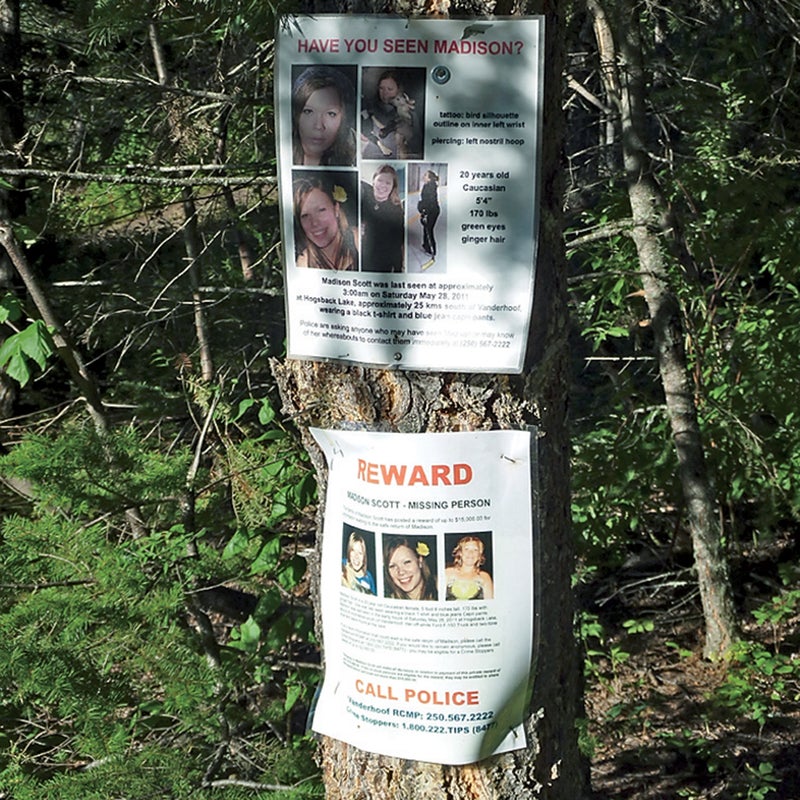
Then, on October 17, 2011, nearly one year after Legebokoff was arrested for Loren’s murder, the RCMP’s E-Prelude unit investigating the 2009–10 disappearances of the three Prince George women charged him with those killings. If the charges are proved, Legebokoff was both a ruthless monster, cruising the dark alleys of Prince George in his black pickup looking for random victims, and the snowboarding small-town boy next door who asked a young family friend to go for a ride and then killed her.
Legebokoff, who goes on trial this year for the four first-degree murders, was already in custody when Maddy Scott disappeared. And the RCMP says it has no evidence linking him to any of the crimes on E-Pana’s list. That leaves the residents of northern B.C. facing three unnerving possibilities: there is still a serial killer out there, maybe more than one; the other murders were committed by different men who likely still live among them; or they are losing their daughters to a combination of both. It’s hard to figure which alternative is more frightening.
The RCMP investigations have no shortage of critics. “They’ve got all this money and these resources and spent two years inputting all this information into their super-computer,” says Ray Michalko, an RCMP constable turned private investigator. “When it didn’t spit out the name of a killer, they said, ‘Uh-oh, what do we do now?’ ”
I met Michalko one morning at an east side Vancouver coffeehouse. At six-two, 240 pounds, with arms that take up more than his share of the table, Michalko, 64, still looks like he could handle himself in the Manitoba mining-town bar brawls where he cut his teeth as a Mountie. Michalko left the force after he was transferred to Vancouver, where they expect their cops to be more refined. “If somebody in Manitoba told you to fuck off,” he says, “you flattened him, and there was no flap. Here, it was a lot different.”

Along with missing the two-fisted form of frontier justice, Michalko says he grew weary of what he calls the RCMP’s “dysfunctional bureaucracy.” He’s spent the past 14 years working as a PI. In late 2005, while he was sitting in his home near Vancouver, a news story came on about Tamara Chipman, another young woman gone missing from Highway 16.
“I’m bitching to my wife that even I could solve this case, that the RCMP haven’t done bugger all! And she said, ‘Well, instead of just talking, why don’t you try to do something about it!’ ”
Michalko’s wife shares a home office with her husband, and he soon had a wall covered with pin maps, case notes, and head shots of dead women. “She recently asked me to take those photos down,” he says.
Without access to the RCMP’s state-of-the-art Violent Crime Linkage Analysis System software or its warehouse full of files on the highway murders, Michalko still thought he had an edge. “I know from experience that the natives do not like the RCMP,” he says. “They just don’t trust them or the government. That bad blood goes all the way back to the residential schools and to when Canada outlawed the potlatch, which was the natives’ way of ensuring that every family in the band had enough to live on. Now in those communities there’s a lot of misery.”
Claims of institutional racism within the RCMP toward members of the First Nations are often brought up in discussions of the highway murders. According to the Native Women’s Association of Canada, in 2010 the country’s average clearance rate for homicides was 84 percent, while for indigenous women it was 53 percent. It falls below even that dismal average in B.C., where only 51 percent of the murders of native women are ever cleared. (The RCMP’s Annie Linteau says that each case, regardless of the victim’s ethnicity, is thoroughly investigated.)
Michalko thought the key to solving the cases was old-fashioned, door-knocking police work in local villages. And for such a big, pasty white guy, Michalko has always had a good relationship with Canada’s aboriginals. “They’re good people,” he says. “A lot of them have drug and alcohol problems, and they drive me crazy sometimes, but I really like them. I think I must have been one of them in a past life.”

Limited to working nights, weekends, and whatever spare hours he had, Michalko jump-started his Highway of Tears investigation by putting ads in small-town newspapers along the Yellowhead. “I just said, ‘If you know anything about the missing or murdered girls, call me.…’ And the phone started ringing.”
Michalko says that his first big break came in March 2008, when he found someone who claimed to be a witness to the murder of 16-year-old Ramona Wilson on the outskirts of Smithers. He immediately brought that person to the RCMP. “Problem was,” he says, “their theory was that this girl had been done by a serial killer. My witness blew that idea out of the water, and they didn’t like that. I talked to the witness a couple of weeks later, and while the RCMP did talk to the guy he identified as the killer, to my knowledge no one followed up again. So I wrote the RCMP and told them that if they had no objection, I was going to continue investigating. They wrote back telling me that not only was I not going to work on that case, but I wasn’t working on any other case or they’d charge me with obstruction of justice.”
Michalko’s involvement caught the attention of the local press. “The RCMP’s attitude toward me was the best thing that could have happened,” Michalko says. “Now the First Nations people up there were certain I wasn’t one of the RCMP boys.” (The RCMP eventually backed off and said it welcomes input from citizens and follows up on all leads. Meanwhile, Linteau says she can’t comment on the Wilson investigation because it’s ongoing.)
Most recently, Michalko has been working with Claudia Williams to find out what happened to her younger sister, Alberta, one of the E-Pana 18, who disappeared on August 25, 1989. The sisters, members of the Gitanyow band, had gone to a Prince Rupert hot spot called Bogey’s Cabaret to celebrate the end of the summer salmon season, which they’d spent working together at a nearby cannery. After last call, Alberta asked her sister to accompany her and some friends to a party. Claudia looked away to talk to someone for a few minutes. When she turned back, the whole group, including her sister, was gone. That was the last time she saw Alberta. A month later, hikers found her body off Highway 16.

Claudia says that Alberta knew everyone she was last seen with. Still, almost 23 years later the murder remains unsolved. “Every one of those people are covering up, and that’s going to break down,” says Claudia, now 52, who was 30 at the time, four years older than her sister. She has been keeping the investigation alive, badgering the RCMP, soliciting information through social networks and old-fashioned fliers, and hiring Michalko, who’s charging her a fee of one Canadian loonie.
All along, Michalko has theorized that most of the highway murders were not committed by a serial killer but had happened under horrifically mundane circumstances: the bad uncle, the boyfriend from hell, the date rape or domestic-abuse case that went from bad to worse. Still, all the hours and all the tips have yet to lead to an arrest. “I can’t tell you how many times I’ve said, ‘OK, this is it, I give up,’ ” says Michalko, who estimates he’s worked 40 hours a month on the Highway of Tears cases since taking them on six years ago. “Within a day or two of that, though, my phone rings and, Hey, this is good information! I’m still convinced I’m going to solve one of these, but I thought it would be easier.”
On the drive back from Prince Rupert to Prince George, I stop again in Vanderhoof. Down Blackwater Road on a night with no party, Hogsback Lake lies so still I can hear the kisses as fish rise to the surface to feed.
The Scott family has spent many nights camping out at the lake, returning again and again to the woods where Maddy was last seen. Volunteers continue to expand the search area; they’ve now covered hundreds of miles. Calls come in from psychics around the world.
The idea that someone from this little town that people say has always been such a wonderful place to live might be keeping a dark secret haunts locals. How can somebody just disappear like that from a group of people she knew? Somebody knows. Why aren’t they saying something?
A few minutes from any of the towns or settlements and you’re in vast forest. Convenient for anyone trying to dump a body, skid roads slash through every sizable patch of trees near the highway, especially east of the mountains.
“For investigators,” says the RCMP’s Rob Vermeulen, “it’s frustrating any time you know there’s information out there that could help but hasn’t gotten to you yet. We continue to appeal to people who, for whatever reason, haven’t passed on that information to please get that to us.”
In another of the area’s terrible turns, Vanderhoof local Fribjon Bjornson went missing early this year. A father of two young children, 28-year-old “Frib” had recently hired on at a logging camp in Fort St. James. According to his mother, Eileen, Frib was friends with Maddy Scott and had been very troubled over her disappearance. A couple of weeks after he vanished in mid-January, police received a tip that led them to partial human remains in a neighborhood on the nearby Nak’azdli reservation. They identified them as Frib’s by his dental records. The rest of his body has not been found.
No charges have been laid in Bjornson’s murder, and the RCMP and Eileen say there is no connection between his case and Maddy’s. But in this small rural community that has seen three of its young people murdered or gone missing, and another from a nearby town charged as a serial killer—all within 14 months—the lack of answers only feeds the sense of dread.
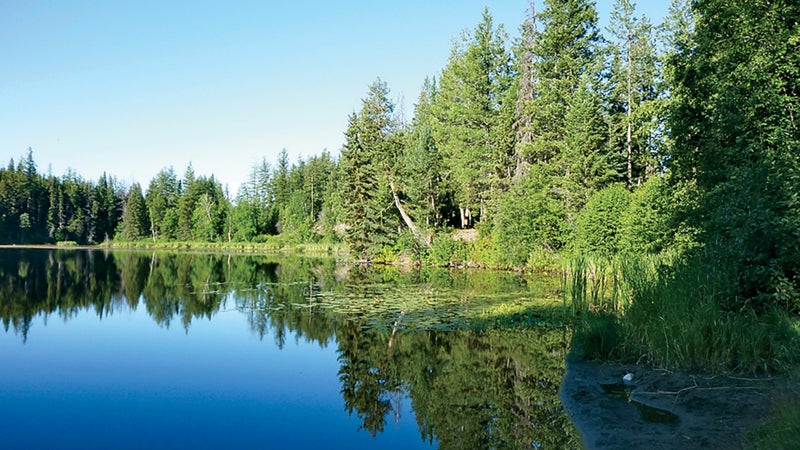
Today, some neighbors are looking sideways at each other. Some families find themselves treated as outcasts because their sons were at the party with Maddy and have come under suspicion. Wild rumors circulate about human trafficking, dungeonlike bunkers on rural properties near Hogsback Lake, and the involvement of local drug dealers. Vanderhoof mayor Gerry Thiessen says this has always been a place that pulls together through hard times, but even he describes the pain as “gut-wrenching.” It’s twisting the little town into knots.
As I drove out of Vanderhoof after 10 on a rainy night, the small pool of light cast by the Scott Foods shopping center quickly faded as I headed east on Highway 16. At the edge of town, my headlights picked out a face in the blackness along the side of the road. I was so surprised that it took me a moment to realize it belonged to a woman in dark clothes, hitchhiking. I was already too far past her to stop and back up, so as soon as I could, I made a U-turn. I wanted to pick her up, ask what the hell was worth the risk, and then make sure she got there safely. By the time I made it back to the spot where she’d been standing—within sight of a big billboard asking for help finding Maddy Scott—she was climbing into a black pickup.


